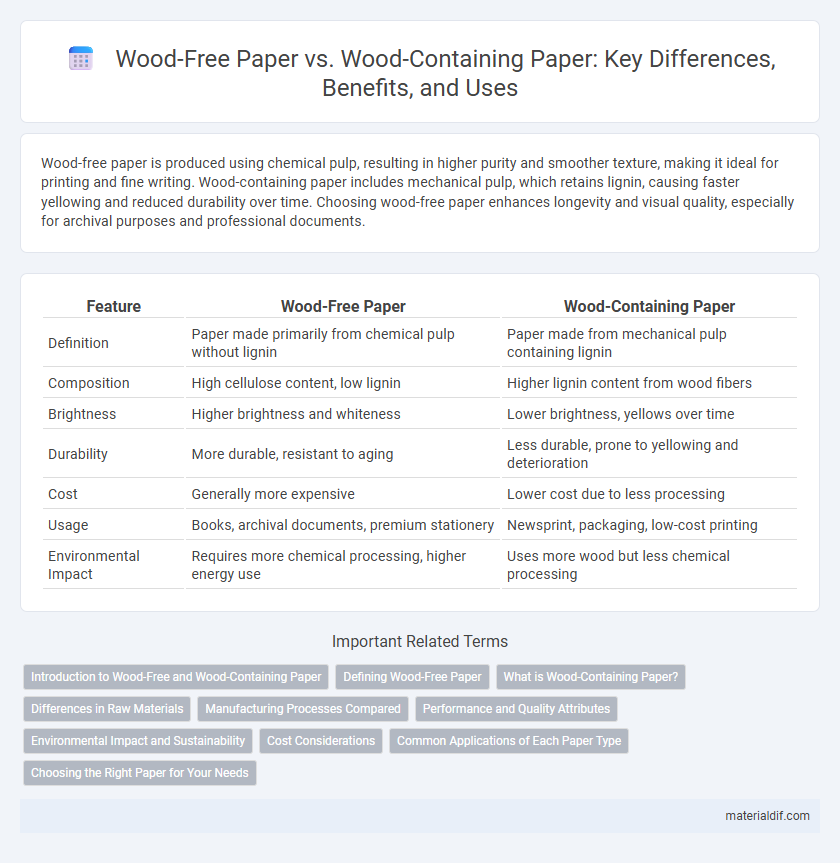Wood-free paper is produced using chemical pulp, resulting in higher purity and smoother texture, making it ideal for printing and fine writing. Wood-containing paper includes mechanical pulp, which retains lignin, causing faster yellowing and reduced durability over time. Choosing wood-free paper enhances longevity and visual quality, especially for archival purposes and professional documents.
Table of Comparison
| Feature | Wood-Free Paper | Wood-Containing Paper |
|---|---|---|
| Definition | Paper made primarily from chemical pulp without lignin | Paper made from mechanical pulp containing lignin |
| Composition | High cellulose content, low lignin | Higher lignin content from wood fibers |
| Brightness | Higher brightness and whiteness | Lower brightness, yellows over time |
| Durability | More durable, resistant to aging | Less durable, prone to yellowing and deterioration |
| Cost | Generally more expensive | Lower cost due to less processing |
| Usage | Books, archival documents, premium stationery | Newsprint, packaging, low-cost printing |
| Environmental Impact | Requires more chemical processing, higher energy use | Uses more wood but less chemical processing |
Introduction to Wood-Free and Wood-Containing Paper
Wood-free paper primarily consists of chemical pulp, which undergoes extensive processing to remove lignin, resulting in higher brightness, durability, and longevity suitable for archival and premium printing uses. Wood-containing paper includes mechanical pulp retaining lignin, offering cost-effectiveness and higher opacity but reduced durability and yellowing tendencies. Understanding these fundamental differences is crucial for selecting paper types aligned with specific printing, archival, or environmental requirements.
Defining Wood-Free Paper
Wood-free paper refers to paper manufactured without mechanical wood pulp, instead relying on chemical pulp that removes lignin to enhance durability and brightness. It is often preferred for high-quality printing due to its reduced acidity, which improves longevity and reduces yellowing over time. In contrast, wood-containing paper includes mechanical pulp, resulting in lower cost but reduced durability and brightness.
What is Wood-Containing Paper?
Wood-containing paper is produced from pulp derived directly from wood fibers, retaining lignin and other natural components. This type of paper generally exhibits higher strength and durability due to the preserved fiber structure. Commonly used in newspapers and packaging, wood-containing paper offers a cost-effective solution with notable print quality.
Differences in Raw Materials
Wood-free paper is primarily made from chemical pulp, which involves removing lignin and other impurities from wood fibers to produce a smoother, brighter paper. Wood-containing paper, also known as mechanical or groundwood paper, retains lignin and uses more mechanical processes, resulting in a coarser texture and lower brightness. These raw material differences impact durability, print quality, and environmental considerations between the two paper types.
Manufacturing Processes Compared
Wood-free paper is produced using chemical pulping methods that remove lignin, resulting in higher purity cellulose fibers and enhanced brightness. In contrast, wood-containing paper employs mechanical pulping which retains lignin, leading to lower production costs but reduced durability. Chemical pulping involves processes like kraft or sulfite methods, while mechanical pulping relies on grinding wood chips to separate fibers without significant lignin removal.
Performance and Quality Attributes
Wood-free paper, typically made from chemical pulp, offers superior brightness, smoothness, and durability compared to wood-containing paper, which uses mechanical pulp and retains lignin. The absence of lignin in wood-free paper results in enhanced aging properties, reduced yellowing, and improved archival quality. Wood-containing paper, while more affordable and environmentally friendly due to less processing, often sacrifices tensile strength and surface uniformity, impacting print clarity and overall aesthetic quality.
Environmental Impact and Sustainability
Wood-free paper, primarily made from chemical pulp, offers a reduced environmental impact due to lower lignin content, resulting in less chemical usage and higher recyclability compared to wood-containing paper. Wood-containing paper, which incorporates mechanical pulp with lignin, tends to consume more energy and produces higher emissions during manufacturing, leading to greater deforestation concerns. Sustainable practices favor wood-free paper for its longer lifespan, enhanced recyclability, and decreased reliance on virgin timber, contributing to overall forest conservation.
Cost Considerations
Wood-free paper typically incurs higher production costs due to the use of chemical pulping processes that remove lignin, resulting in improved brightness and durability. Wood-containing paper, often produced via mechanical pulping, offers lower manufacturing expenses but may compromise on longevity and print quality. Businesses must weigh these cost considerations against end-use requirements and sustainability goals when selecting paper types.
Common Applications of Each Paper Type
Wood-free paper is commonly used in high-quality printing applications such as books, magazines, and office stationery due to its smooth surface and durability. Wood-containing paper, often referred to as groundwood or mechanical paper, is frequently utilized for newspapers, catalogs, and flyers because of its cost-effectiveness and faster production process. The choice of paper type directly impacts print clarity, longevity, and environmental considerations in various commercial and publishing sectors.
Choosing the Right Paper for Your Needs
Wood-free paper, typically made from chemical pulp, offers higher durability, smoother texture, and improved printing quality compared to wood-containing paper, which includes mechanical pulp and retains lignin resulting in lower brightness and faster yellowing. Choosing wood-free paper is ideal for documents requiring longevity and sharp image reproduction, while wood-containing paper suits cost-sensitive applications like newsprint or packaging. Assessing the specific requirements for durability, appearance, and budget ensures selecting the most efficient and sustainable paper type for your project.
Wood-free paper vs Wood-containing paper Infographic

 materialdif.com
materialdif.com